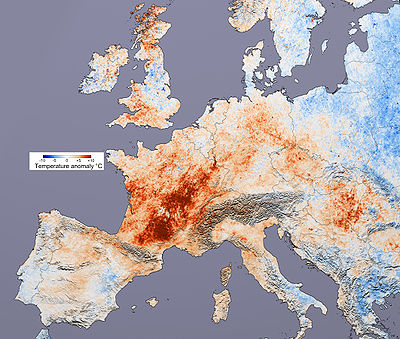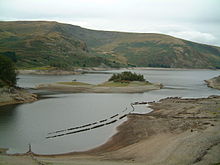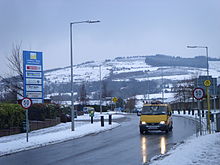European Heat Wave of 2003
| 2003 European heat wave | |
|---|---|
| Dates | June 2003 to August 2003 |
| Areas affected | Mostly western Europe |
The 2003 European heat wave was the hottest summer on record in Europe since at least 1540.[1] France was hit especially hard. The heat wave led to health crises in several countries and combined with drought to create a crop shortfall in parts of Southern Europe. Peer reviewed analysis places the European death toll at 70,000.[2]

By country
France
In France, there were 14,802 heat-related deaths (mostly among the elderly) during the heat wave, according to the French National Institute of Health.[4][5] France does not commonly have very hot summers, particularly in the northern areas,[6] but seven days with temperatures of more than 40 °C (104 °F) were recorded in Auxerre, Yonne during July and August 2003. Because of the usually relatively mild summers, most people did not know how to react to very high temperatures (for instance, with respect to rehydration), and most single-family homes and residential facilities built in the last 50 years were not equipped with air conditioning. Furthermore, while there were contingency plans for a variety of natural and man-made catastrophes, high temperatures had rarely been considered a major hazard.
The catastrophe occurred in August, a month in which many people, including government ministers and physicians, are on holiday. Many bodies were not claimed for many weeks because relatives were on holiday. A refrigerated warehouse outside Paris was used by undertakers as they did not have enough space in their own facilities. On September 3, 2003, fifty-seven bodies still left unclaimed in the Paris area were buried.
The high number of deaths can be explained by the conjunction of seemingly unrelated events. Most nights in France are cool, even in summer. As a consequence, houses (usually of stone, concrete or brick construction) do not warm too much during the daytime and radiate minimal heat at night, and air conditioning is usually unnecessary. During the heat wave, temperatures remained at record highs even at night, preventing the usual cooling cycle. Elderly persons living by themselves had never faced such extreme heat before and did not know how to react or were too mentally or physically impaired by the heat to make the necessary adaptations themselves. Elderly persons with family support or those residing in nursing homes were more likely to have others who could make the adjustments for them. This led to statistically improbable survival rates with the weakest group having fewer deaths than more physically fit persons; most of the heat victims came from the group of elderly persons not requiring constant medical care or living alone without immediate family.
That shortcomings of the nation's health system could allow such a death toll is a matter of controversy in France. The administration of President Jacques Chirac and Prime Minister Jean-Pierre Raffarin laid the blame on families who had left their elderly behind without caring for them, the 35-hour workweek, which affected the amount of time doctors could work and family practitioners vacationing in August. Many companies traditionally closed in August, so people had no choice about when to vacation. Family doctors were still in the habit of vacationing at the same time. It is not clear that more physicians would have helped as the main limitation was not the health system but locating old people needing assistance.
The opposition, as well as many of the editorials of the local press, have blamed the administration. Many blamed Health Minister Jean-François Mattei for failing to return from his vacation when the heat wave became serious, and his aides for blocking emergency measures in public hospitals (such as the recalling of physicians). A particularly vocal critic was Dr. Patrick Pelloux, head of the union of emergency physicians, who blamed the Raffarin administration for ignoring warnings from health and emergency professionals and trying to minimize the crisis. Mattei lost his ministerial post in a cabinet reshuffle on March 31, 2004.
Not everyone blamed the government. "The French family structure is more dislocated than elsewhere in Europe, and prevailing social attitudes hold that once older people are closed behind their apartment doors or in nursing homes, they are someone else's problem," said Stéphane Mantion, an official with the French Red Cross. "These thousands of elderly victims didn't die from a heat wave as such, but from the isolation and insufficient assistance they lived with day in and out, and which almost any crisis situation could render fatal."[7]
Portugal
There were extensive forest fires in Portugal. Five percent of the countryside and ten percent of the forests (215,000 hectares[5]) were destroyed, an estimated 4,000 square kilometres (1,500 sq mi). Eighteen people died in the fires and there were an estimated 1866 to 2039 heat related deaths over all.[8] Temperatures reached as high as 48 °C (118 °F) in Amareleja. The first of August was the hottest day in centuries, with night temperatures well above 30 °C (86 °F). A freak storm developed on the southern region during that dawn. A hot, strong saharan wind blew during the subsequent days of that week.[9][10]
Netherlands
There were about 1,500[5][11] heat related deaths in the Netherlands, again largely the elderly. The heat wave here broke no records, although 4 tropical weather designated days in mid-July, preceding the official wave, are not counted due to a cool day in between and the nature of the Netherlands specification/definition of a heat wave.[11] The highest temperature recorded this heatwave was on 7 August, when in Arcen, in Limburg, a temperature of 37.8 °C was reached, 0.8 °C below the national record (since 1704). It happened only twice that a higher temperature was recorded. On 8 August a temperature of 37.7 °C was recorded, and 12 August saw a temperature of 37.2 °C.[12]
Spain
There were 141 deaths officially attributed to the heat wave, although an increase of about 13,000 deaths over the previous year was reported.[13] Temperature records were broken in various cities including 45.1 °C (113.2 °F) in Jerez , 41 °C (106 °F), with the heat wave being more felt in typically cooler northern Spain. Thus, record temperatures were reached in Girona,[14] 38.8 °C (101.8 °F) in Burgos,[15] 38.6 °C (101.5 °F) in San Sebastián,[15] 36 °C (97 °F) in Pontevedra[16] and 36 °C (97 °F) in Barcelona.[17] In Sevilla was 45.2 °C (113.4 °F) although the record was in 1995 with 46.6 °C (115.9 °F).[18]
Italy
The summer 2003 was among the warmest in the last three centuries,[19] and the maximum temperatures of July and August remained above 30 °C.[19] The high humidity emphasized the perception of heat and population suffering.[19] Several reports about strong positive temperature anomalies exist, for instance from Toscana[20] and Veneto.[21] Temperatures rose far above their means in most of the Country and reached very high mean values especially in terms of heat persistence; for instance the weather station of Catenanuova, in Sicily, had a monthly mean of 31.5 °C (88.7 °F) in July 2003, with an absolute maximum of 46.0 °C (114.8 °F) on 17 July, with monthly mean maximum temperatures of 36.0 °C (96.8 °F), 38.9 °C (102.0 °F) and 38.0 °C (100.4 °F) in June, July and August 2003 respectively.[22]
Germany
In Germany, a record temperature of 40.4 °C (104.7 °F) was recorded at Roth bei Nürnberg, Bavaria.[citation needed] But some experts suspect that the highest temperatures occurred in the upper Rhine plain, which is known for very high temperatures. At some stations (private stations, for example Mannheim or Frankenthal), temperatures over 41 °C (106 °F) were reported, but not recognized by official statistics. With only half the normal rainfall, rivers were at their lowest this century,[citation needed] and shipping could not navigate the Elbe or Danube. Around 9,000 people[5]—mostly elderly—died during the 2003 heatwave in Germany.
Switzerland
Melting glaciers in the Alps caused avalanches and flash floods in Switzerland. A new nationwide record temperature of 41.5 °C (106.7 °F) was recorded in Grono, Graubünden.[23]
United Kingdom

The United Kingdom in general was suffering from a warm summer with temperatures well above average. However, Atlantic cyclones brought cool and wet weather for a short while at the end of July and very beginning of August before the temperatures started to increase substantially from 3 August onwards. Several weather records were broken in the United Kingdom, including the UK's highest recorded temperature 38.5 °C (101.3 °F) at Gravesend in Kent on 10 August. Scotland also broke its highest temperature record with 32.9 °C (91.2 °F) recorded in Greycrook in the Scottish borders on 9 August.[24] According to the BBC around 2,000 more people than usual died in the United Kingdom during the 2003 heatwave.[25]
Ireland
The summer of 2003 was warmer than average in Ireland, but the heat was far less pronounced there than in the rest of Europe. August was by far the warmest, sunniest and driest month, with temperatures roughly 2°C above average. The highest temperature recorded was 30.3 °C (86.5 °F) at Belderrig, County Mayo on 8 August.[26][27][28]
Effects on crops
Crops which suffered most from drought were grown in Southern Europe.
Wheat
The following shortfalls in wheat harvest occurred as a result of the long drought.[citation needed]The long drought occurred because of the increasing temperature change which affects the whole globe.
- France – 20%
- Italy – 13%
- United Kingdom – 12%
- Ukraine – 75% (Unknown if affected by heatwave or an early freeze that year.)
- Moldova – 80%
Many other countries had shortfalls of 5–10%, and the EU total production was down by 10 million tonnes, or 10%.[citation needed]
Grapes
The heat wave greatly accelerated the ripening of grapes; also, the heat dehydrates the grapes, making for more concentrated juice. By mid-August, the grapes in certain vineyards had already reached their nominal sugar content, possibly resulting in 12°–12.5° wines (see alcoholic degree). Because of that, and also of the impending change to rainy weather, the harvest was started much earlier than usual (e.g. in mid-August for areas that are normally harvested in September).
It is predicted that the wines from 2003, although in scarce quantity, will have exceptional quality, especially in France. The heat wave made Hungary fare extremely well in the Vinalies 2003 International wine contest: a total of nine gold and nine silver medals were awarded to Hungarian winemakers.[29]
Effects on the sea
The anomalous overheating affecting the atmosphere also created anomalies on sea surface stratification in the Mediterranean Sea and on the surface currents as well. A seasonal current of the Central Mediterranean Sea, the Atlantic Ionian Stream (AIS), was affected by the warm temperatures, resulting in modifications in its path and intensity. The AIS is important for the reproduction biology of important pelagic commercial fish species, so the heatwave may have influenced indirectly the stocks of these species. Further studies will be addressed in this direction.[30]
See also
- 2006 European heat wave
- 2010 Northern Hemisphere summer heat wave
- 2010 Sahel famine
- Drought
References
- ^ WMO: Unprecedented sequence of extreme weather events – News – Professional Resources – PreventionWeb.net
- ^ Robine, Jean-Marie; Siu Lan K. Cheung, Sophie Le Roy, Herman Van Oyen, Clare Griffiths, Jean-Pierre Michel, François Richard Herrmann (2008). "Death toll exceeded 70,000 in Europe during the summer of 2003". Comptes Rendus Biologies 331 (2): 171–178. doi:10.1016/j.crvi.2007.12.001. ISSN 1631-0691. PMID 18241810. Retrieved 17 May 2010.
- ^
- ^ Earth Policy Institute article; data for more countries:
- ^ a b c d [1] Archived August 29, 2008 at the Wayback Machine
- ^ CIA-The World Factbook, Archived 14 February 2010 at WebCite
- ^ www.time.com
- ^
- ^ "Portugal Diário" (in (Portuguese)). Portugaldiario.iol.pt. Retrieved 15 March 2010.
- ^ InterScience
- ^ a b "View Article". Eurosurveillance. Archived from the original on 13 March 2010. Retrieved 15 March 2010.
- ^ KNMI, Klimatologie, Job Verkaik, Jon Nellestijn, Rob Sluijter. "KNMI – Daggegevens van het weer in Nederland". Archived from the original on 11 August 2009. Retrieved 6 August 2009.
- ^
- ^ History for Girona, Spain. Weather Underground. 2003-08-13. Last Retrieved 9 February 2007.
- ^ a b "Valores extremos – Agencia Estatal de Meteorología – AEMET. Gobierno de España" (in (Spanish)). Aemet.es. Archived from the original on 17 March 2010. Retrieved 15 March 2010.
- ^ History for Vigo, Spain. Weather Underground. August 2003. Last Retrieved 9 February 2007.
- ^ History for Barcelona, Spain. Weather Underground. 2003-08-13. Last Retrieved 9 February 2007.
- ^ "Agencia Estatal de Meteorología – AEMET. Gobierno de España" (in (Spanish)). Inm.es. 27 February 2010. Retrieved 15 March 2010.
- ^ a b c "L'ondata di calore dell'estate 2003". Ministero della Salute, L'ondata di calore dell'estate 2003. Ministero della Salute. Retrieved 23 April 2011.
- ^
- ^ (Analisi meteo-climatica inverno 2002/2003)
- ^ "Table I – Daily temperature readings". Osservatorio delle Acque (Water Monitoring) Annual data. Dipartimento dell'Acqua e dei Rifiuti. 2003. p. 45. Retrieved 23 April 2011.
- ^ "MeteoSwiss – Switzerland". Archived from the original on 3 May 2008.
- ^ "Great weather events: Temperatures records fall in summer 2003". Met Office. 19 November 2008. Archived from the original on 16 May 2007. Retrieved 15 March 2010.
- ^ "Deaths up by 2,000 in heatwave". BBC. 3 October 2003. Retrieved 3 December 2011.
- ^ Met Éireann – Monthly Weather Bulletin (June 2003)
- ^ Met Éireann – Monthly Weather Bulletin (July 2003)
- ^ Met Éireann – Monthly Weather Bulletin (August 2003)
- ^ "Union des oenologues de France". Oenologuesdefrance.fr. Archived from the original on 9 April 2010. Retrieved 15 March 2010.
- ^ "Effects of 2003 heatwave on the Sea Surface in Central Mediterranean". Ocean-sci.net. Retrieved 15 March 2010.
| ||||||||||||||||||||
| ||||||||||||||||||||||||||||||||
